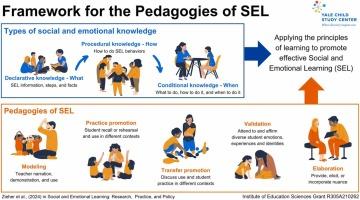SEL for Students with Special Needs: Strategies to Support social-Emotional Learning
Social-emotional learning (SEL) empowers students with the skills to understand and manage emotions, set positive goals, build healthy relationships, and make responsible decisions. But when it comes to students with special needs, supporting social-emotional learning requires targeted strategies and accommodations. In this comprehensive guide, we’ll explore the importance of SEL for students with special needs, share practical strategies teachers and caregivers can use, and showcase real examples of success in inclusive classrooms.
Why is Social-Emotional Learning (SEL) Crucial for Students with Special Needs?
SEL provides a foundation for academic success, positive behavior, and wellbeing for all learners. For students with disabilities or special needs—including those with autism spectrum disorder (ASD), ADHD, learning disabilities, or emotional and behavioral challenges—SEL is especially significant. These students often face unique hurdles in interaction, self-regulation, and social interaction.
- Enhances Communication skills: SEL fosters the ability to express thoughts, needs, and emotions in healthy ways, bridging gaps caused by speech or language difficulties.
- Promotes Emotional Regulation: Many special needs students struggle with self-control. SEL teaches coping mechanisms and emotional awareness.
- Supports Inclusion: SEL helps create a more welcoming classroom where diverse learners feel understood and connected.
- Improves Academic Performance: When students feel safe and supported, they’re more likely to engage and achieve academically.
Key challenges in Implementing SEL for Special Needs Learners
Before exploring solutions, it’s crucial to recognize some common challenges teachers and caregivers face:
- Diverse needs: No two students are the same. Disabilities range widely, demanding differentiated approaches.
- communication Barriers: Some students may be non-verbal or have limited language abilities.
- Sensory Sensitivities: Overwhelm from sights, sounds, or physical contact can interfere with participation.
- Rigid Thinking: Difficulty with flexibility can make adapting to SEL routines hard.
- Inconsistent Social Skills: Social cues, body language, and empathy may not come naturally.
Proven Strategies to Support SEL for Students with Special Needs
Effective SEL for students with special needs blends evidence-based practices with individualization. Hear are strategies to foster SEL in special education or inclusive settings:
1. Individualize SEL Goals and Instruction
-
Collaborate with IEP teams to embed SEL objectives into Individualized education Plans.
-
Set small, measurable goals (e.g., maintaining eye contact, identifying one emotion) tailored to each student’s abilities.
-
Use regular progress monitoring to adjust SEL strategies as needed.
2. Use Visual Supports and Social stories
-
Create visual schedules, feelings charts, and step-by-step guides with images or symbols.
-
Develop social stories to model social situations—from making friends to managing disappointment.
-
Incorporate videos, role-play, and puppets for more engaging practice.
3. Teach Explicit Emotional Literacy and Regulation Skills
-
Build a vocabulary of feelings using pictures and stories.
-
Teach students to identify physical cues for emotions (e.g., clenched fists for anger).
-
Introduce calming techniques such as:
- Deep breathing
- Mindfulness exercises
- Fidget tools and sensory breaks
4.Foster Social Skills through Structured Practice
-
Use structured peer interactions, cooperative games, and group projects to build social skills.
-
Model and role-play greetings, turn-taking, sharing, and viewpoint-taking.
-
Provide real-time feedback and positive reinforcement.
5. Create Predictable and Supportive Environments
-
Establish classroom routines and clear expectations to reduce anxiety.
-
Offer sensory-friendly spaces for students who need a break.
-
Use positive behavior supports (PBS) and celebrate every success,big or small.
6. Collaborate with Families and Multidisciplinary Teams
-
Keep open communication with parents about SEL goals, progress, and opportunities for practice at home.
-
Work with speech-language pathologists, counselors, occupational therapists, and other specialists to align SEL strategies.
Benefits of SEL for Students with Special Needs
when SEL is tailored to special needs students, the benefits extend well beyond the classroom:
- Increased Self-Confidence: Students gain a stronger sense of self-worth and advocacy.
- Stronger Relationships: Improved empathy and communication lead to deeper friendships and better peer interactions.
- Better Conflict resolution: With explicit strategies, students can resolve disagreements peacefully.
- Resilience and Coping: SEL teaches practical ways to manage change and stress.
- Family Wellbeing: Parents and caregivers experience reduced stress as students better manage emotions at home.
Practical Tips for Implementing SEL in Special Education Classrooms
- Start Simple: focus on one SEL skill at a time, like understanding “happy” vs. “sad.”
- Use Repetition: Practice skills daily and in different contexts for greater retention.
- Incorporate Students’ Interests: Connect lessons to favorite subjects, characters, or activities.
- Celebrate Progress: Reward growth with praise,certificates,or share successes with families.
- Stay Patient and Flexible: Every learner progresses at their own pace. Adjust methods as needed.
- Leverage Technology: Try SEL apps and digital games designed for diverse learning needs.
first-Hand Experience: Success Story from an SEL Classroom
an Inclusive Classroom Triumph
Ms. Brown, a special education teacher, noticed that one of her students with autism struggled with joining group activities and expressing frustration. By incorporating daily SEL routines—including emotion check-ins with visual cards and practicing “calm-down corners”—the student gradually learned to name his feelings and seek help when overwhelmed. Peers also participated in structured social activities that encouraged inclusion. By year’s end, not only did the student spend more time learning alongside classmates, but other students also showed a greater sense of empathy and community.
Resources to Support SEL for Students with Special Needs
- CASEL (Collaborative for Academic, Social, and Emotional Learning) – Frameworks and tools for SEL implementation.
- Autism Research Institute – Social skills resources for autistic learners.
- Understood.org – Tips and articles for learning differences and SEL support.
Conclusion: Empowering Every Learner Through SEL
SEL for students with special needs is not just an “add-on”—it’s essential for their overall growth and success. With intentional strategies, patience, and collaboration among educators, specialists, and families, we can ensure that every student develops the social and emotional skills they need to thrive. By fostering environments where diversity is celebrated and every child feels safe and valued,we’re building a better future for all learners.

